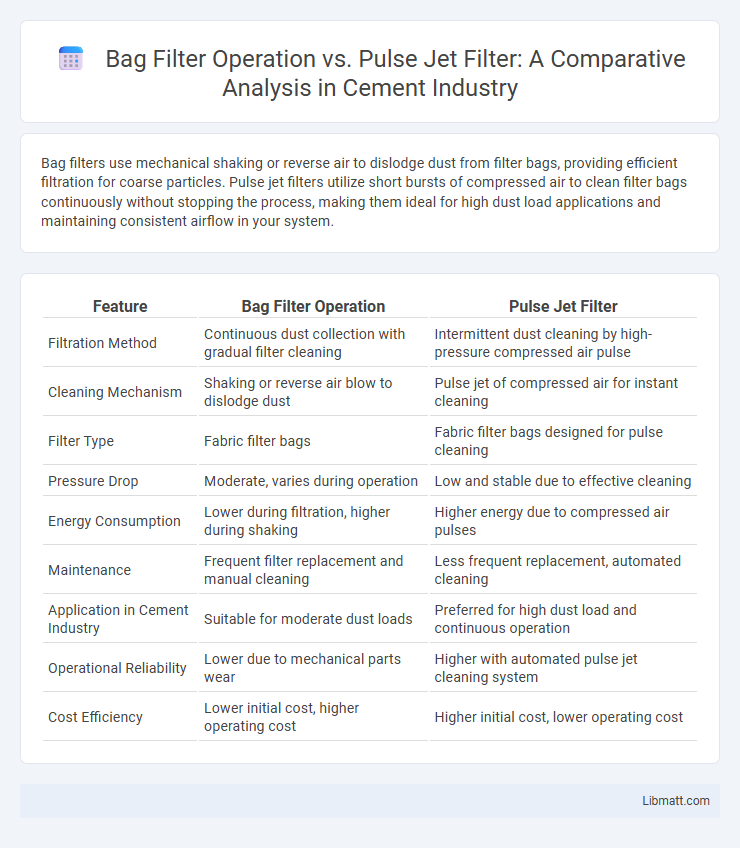Bag filters use mechanical shaking or reverse air to dislodge dust from filter bags, providing efficient filtration for coarse particles. Pulse jet filters utilize short bursts of compressed air to clean filter bags continuously without stopping the process, making them ideal for high dust load applications and maintaining consistent airflow in your system.
Table of Comparison
| Feature | Bag Filter Operation | Pulse Jet Filter |
|---|---|---|
| Filtration Method | Continuous dust collection with gradual filter cleaning | Intermittent dust cleaning by high-pressure compressed air pulse |
| Cleaning Mechanism | Shaking or reverse air blow to dislodge dust | Pulse jet of compressed air for instant cleaning |
| Filter Type | Fabric filter bags | Fabric filter bags designed for pulse cleaning |
| Pressure Drop | Moderate, varies during operation | Low and stable due to effective cleaning |
| Energy Consumption | Lower during filtration, higher during shaking | Higher energy due to compressed air pulses |
| Maintenance | Frequent filter replacement and manual cleaning | Less frequent replacement, automated cleaning |
| Application in Cement Industry | Suitable for moderate dust loads | Preferred for high dust load and continuous operation |
| Operational Reliability | Lower due to mechanical parts wear | Higher with automated pulse jet cleaning system |
| Cost Efficiency | Lower initial cost, higher operating cost | Higher initial cost, lower operating cost |
Introduction to Industrial Filtration Systems
Industrial filtration systems play a crucial role in controlling air pollution and maintaining workplace safety by removing particulate matter from gas streams. Bag filters operate by trapping particles on fabric media as gas passes through, requiring periodic manual or mechanical shaking to clean the filter bags. Pulse jet filters enhance efficiency by using high-pressure air pulses to clean the bags automatically, offering continuous operation and improved dust removal performance for your industrial processes.
Overview of Bag Filter Operation
Bag filter operation involves air or gas passing through a fabric filter bag that captures dust and particulate matter on its surface, allowing clean air to pass through. The collected dust forms a cake that improves filtration efficiency until it reaches a certain thickness, prompting cleaning cycles using methods like shaking or reverse air flow. Your system's performance depends on factors such as airflow rate, dust type, and filter material to maintain optimal filtration and minimize pressure drop.
Fundamentals of Pulse Jet Filter Systems
Pulse jet filter systems utilize compressed air bursts to clean filter bags by dislodging accumulated dust, enabling continuous operation without shutdown. These systems operate under constant positive pressure, making them suitable for high dust load and temperature environments. The rapid, controlled pulses enhance filter longevity, reduce pressure drop, and improve overall system efficiency compared to traditional bag filter operation.
Key Differences Between Bag Filters and Pulse Jet Filters
Bag filters rely on a fixed, porous fabric to capture particles as air passes through, requiring periodic manual shaking or cleaning to maintain airflow. Pulse jet filters use bursts of compressed air to automatically dislodge dust from the filter media, allowing continuous operation and higher filtration efficiency. Your choice depends on maintenance preferences, operational continuity, and specific dust collection requirements.
Filtration Efficiency Comparison
Bag filters provide reliable particulate capture with moderate filtration efficiency, typically removing 85-95% of particles down to 10 microns. Pulse jet filters offer superior filtration efficiency, often exceeding 99% for submicron particles, due to their continuous cleaning process that maintains optimal filter surface conditions. Your choice between the two depends on the required filtration precision and maintenance preferences.
Maintenance Requirements and Downtime
Bag filter operation demands frequent manual cleaning and bag replacements, resulting in higher maintenance efforts and longer downtime intervals. Pulse jet filters use automated cleaning with compressed air pulses, significantly reducing maintenance frequency and minimizing downtime. Optimizing your filtration system choice based on these factors can improve operational efficiency and reliability.
Energy Consumption and Operational Costs
Bag filter operation typically consumes less energy than pulse jet filters due to lower-pressure drop requirements during filtration. Pulse jet filters require high-pressure compressed air pulses to clean filter bags, resulting in increased energy consumption and higher operational costs. Long-term maintenance expenses are also elevated for pulse jet systems because of frequent wear on nozzles and air compressors.
Airflow and Pressure Drop Considerations
Bag filter operation typically generates a moderate airflow with a consistent pressure drop, ensuring efficient particulate capture through fabric filtration media. Pulse jet filters maintain higher airflow rates by using rapid bursts of compressed air to clean the filter bags, which helps minimize pressure drop fluctuations and sustain system performance. Your choice between the two should consider the specific airflow capacity and pressure drop behavior required for optimal dust collection efficiency.
Applications and Industry Suitability
Bag filters excel in applications requiring fine particulate removal in industries such as cement manufacturing, pharmaceuticals, and food processing due to their low operating cost and reliable filtration performance. Pulse jet filters offer superior suitability for heavy-duty industries like power plants, steel mills, and chemical processing where continuous, high-volume dust collection and frequent cleaning cycles are essential. Both filtration systems are tailored to specific industrial needs, with bag filters favored for low-to-moderate dust loads and pulse jet filters optimized for high-temperature, high-dust environments with minimal downtime.
Choosing the Right Filter System for Your Needs
Bag filter operation relies on mechanical shaking to clean dust-laden air, providing efficient filtration for low to moderate dust concentrations and easy maintenance. Pulse jet filters use short bursts of compressed air to clean filter bags continuously without interrupting the filtration process, making them ideal for high dust loads and continuous operation. You should evaluate your specific dust load, maintenance access, and operational continuity requirements to choose the filter system that best matches your industrial needs.
Bag Filter Operation vs Pulse Jet Filter Infographic

 libmatt.com
libmatt.com